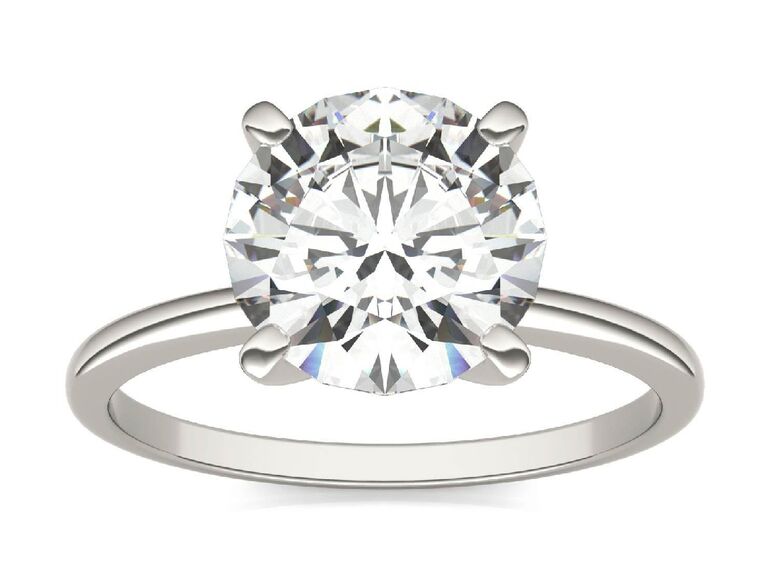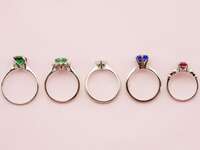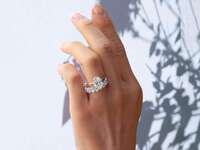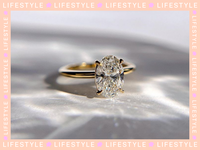A Definitive Breakdown of All the Different Types of Diamonds
Let me fill you in on a little secret: Not all diamonds are created equally. Even if they appear similar to the naked eye, each stone has the potential to be completely different. There are so many types of diamonds on the market today, and a quick Google search will present a seemingly endless list of information and insider lingo. The vast world of gemology can be straight up confusing, especially when you just want to find the perfect engagement ring. So, how many types of diamonds are there, and which is the right one for you?
In addition to understanding diamond shapes, ring metal types and the 4 Cs (AKA the classification system used to grade diamonds), you'll want to familiarize yourself with the different types of diamonds available for purchase. Ultimately, the type of diamond you choose will impact what your engagement ring looks like, as well as how much it costs.
We tapped industry experts to share exactly what you need to know about the most common types of diamonds. Brush up on your jewelry terminology as you start to shop for an engagement ring—that way, you'll know everything you need to before securing your dream sparkler.
In this article:
What is a Diamond?
According to The Knot 2024 Jewelry & Engagement Study, which surveyed over 7,000 couples who got engaged last year, 83% of all engagement rings in the US include a clear diamond, proving its unwavering popularity. But before we define common types of diamonds, it's important to know what a diamond actually is. This beloved engagement ring center stone is a solid form of the element carbon. Its atoms are arranged in a crystal structure called diamond cubic. "Natural diamonds were formed about 100 miles below the earth's surface from one to three billion years ago, making them older than life on earth," says Grant Mobley, Diamond & Industry Expert from the Natural Diamond Council. "They form under rare conditions of extreme heat and pressure inside the earth that causes carbon atoms to crystallize. Millions of years ago, ancient volcanoes blasted toward the surface, trapping diamonds in their lava and bringing them close enough to the surface for us to find."
According to the Gemological Institute of America (GIA), a diamond is the hardest gem on the market. In fact, diamond is also the strongest substance on earth, as it's 58 times harder than any other material found in nature. Because of this, diamonds are usually the most expensive gemstones. A diamond's value is found in its colorless hue and purity, otherwise known as its lack of inclusions within the stone.
Diamonds From a Buyer's Perspective
What does this mean for you, as someone who wants to buy a diamond engagement ring? The most important diamond terminology to know as a consumer are the 4 Cs: a diamond's cut, color, clarity and carat weight, which are defining characteristics that determine its value (read: $$$). A colorless diamond ring with flawless clarity and a high carat size will be much more expensive because of its rarity. Jewelers use the 4 Cs as a guide to help customers choose the right diamond for their budget, as well as their preferred aesthetic.
Diamonds From a Gemologist's Perspective
We can further define exactly what a diamond is by outlining five different types based on their nitrogen atom impurities: Type I: (Type IA diamonds, Type IB diamonds, and Type IAB diamonds) and Type II (Type IIA diamonds, and Type IIB diamonds.) A diamond's nitrogen impurities are measured at the atomic level within the crystal lattice of its makeup. Unlike inclusions, which can sometimes be seen by the naked eye, these impurities require an infrared meter to detect. Since this is high-level industry terminology, you don't have to worry too much about this type of diamond. Your jeweler or gemologist will help you navigate these terms as you shop for a ring.
The Types of Diamonds to Know

What types of diamonds are available to consumers? We define the most common kinds of diamonds below, from mined and lab-grown to treated and synthetic.
Mined Diamonds
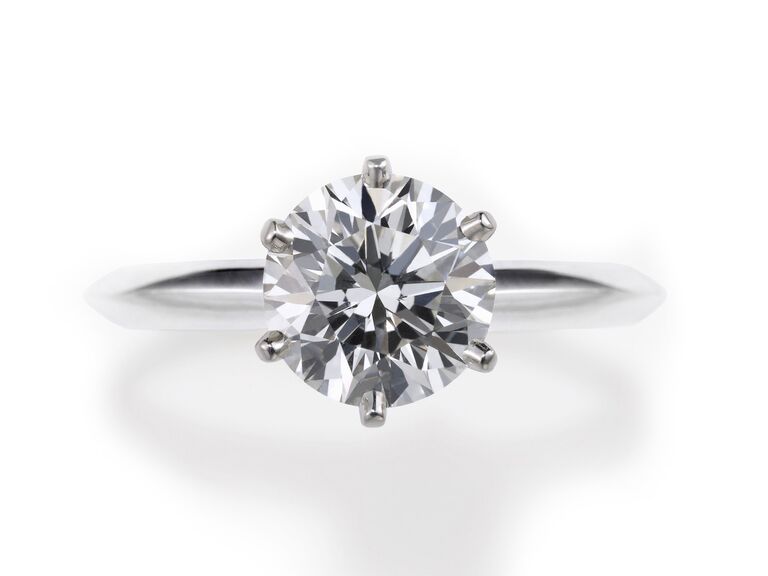
When you think of a "natural diamond," you most likely think of a mined diamond. For years, mined diamonds have been the most common choice for engagement rings and wedding bands. According to the GIA, the earliest diamonds were sourced from water banks in India. The diamond industry we know today, though, began in Africa, where diamonds were discovered in 1866. Over 20 years later, entrepreneur Cecil Rhodes launched De Beers Consolidated Mines in 1888. By 1900, De Beers controlled about 90% of the world's production of rough diamonds. Today, the 50 largest mines account for about 90% of the world's supply of diamonds.
Because mined diamonds are the rarest type of diamond, they're valued higher than others. While the average cost of an engagement ring in the US is $5,200, that number encompasses all center stone materials. Our data found that the average cost of an engagement ring with a mined diamond center stone is significantly higher at $7,600. "Natural diamonds obtain their value from their scarcity as a natural, billion-year-old precious gem," Mobley says. "They've also shown to grow in value over decades as they become rarer."
Lab-Grown Diamonds
In recent years, lab-grown diamonds have emerged as an alternative type of diamond. Thanks to advanced technology, it's possible to create diamonds in a laboratory. And yes, a lab-grown diamond is a true diamond: "A lab-grown diamond's makeup is identical to a mined diamond; the only difference is its origin," explains Don O'Connell, CEO and President of Charles & Colvard. "As opposed to being mined from the earth, lab-grown diamonds are made from carbon, and are therefore chemically, optically and physically identical to mined diamonds."
How does this type of diamond come to life? Akshie Jhaveri, Creative Director and Founder of Grown Brilliance, says the main methods are High-Pressure High Temperature (HPHT) and Chemical Vapor Deposition (CVD). "Both mimic the natural diamond-forming conditions, just in a controlled lab environment," she explains. "With HPHT, a small diamond 'seed' is placed in a press and exposed to extreme heat and pressure—just like deep in the Earth's mantle—until carbon crystallizes around it. CVD, on the other hand, involves placing a diamond seed in a chamber filled with carbon-rich gas, which is heated until the carbon atoms bond layer by layer to form a diamond."
Both of these methods can create a diamond in a few weeks, which is significantly less time than the billions of years it takes to create a mined diamond. After both HPHT and CVD methods, jewelers cut and polish lab-grown diamonds exactly like they would a mined diamond. Since it's made of the same carbon makeup, a lab-grown diamond will shine just as bright as a mined diamond (and it'll usually be accompanied by a lower price tag). "You can't tell them apart with the naked eye or even a standard diamond tester," Jhaveri says. "Only a trained gemologist using specialized equipment can spot the difference."
It's important to clarify the societal impact lab-grown diamonds have. While the diamond industry is committed to ethically sourced gemstones, lab-created diamonds ensure a conflict-free production process. However, while some call lab-grown diamonds an eco-friendly alternative, the production process still leaves a carbon footprint, as with anything that involves a large output of energy.
Raw Diamonds
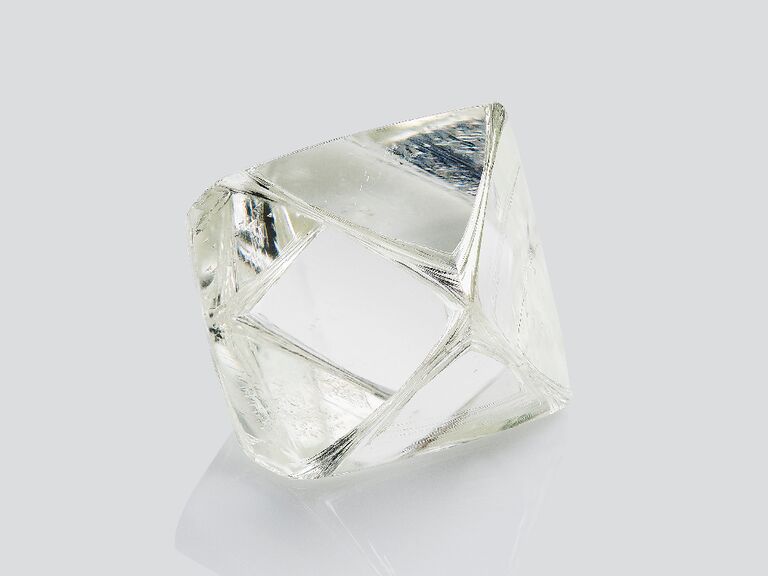
As you learn more about different types of diamonds, you may come across the phrase "raw diamond." Simply put, a raw diamond is one that has not been polished or cut. It's the diamond in its original form, not the sparkling stone you're used to seeing on engagement rings. Because it's not polished, a raw diamond tends to look cloudier than a traditional white diamond thanks to its rough, jagged edges. "When a diamond is faceted, the cutter grinds away material to shape the final stone," says Emily Langmade, Director of Design and Development at Frank Darling. "That leftover material turns into diamond dust—it can't be reused or recut into smaller diamonds."
Naturally Colored Diamonds

While many diamond engagement rings are colorless, that's not always the case. Fancy-colored diamonds are still true diamonds and are not to be confused with colored gemstones like sapphires, emeralds or rubies. "While white diamonds may dominate the market, diamonds actually come in a wide range of colors, each varying in intensity," says Langmade. "These colors come from tiny imperfections in the carbon structure—too small to see, but enough to change how light moves through the stone, making us perceive different hues. Most natural diamonds have a yellowish tint due to nitrogen, but other elements and conditions can create rare colors like blue (boron), green (radiation exposure), or red and pink (subtle shifts in the carbon lattice)."
As you're shopping, it's important to know that naturally colored diamonds are not commonly found in stores. "True fancy colored diamonds are a very rare occurrence," Mobley says. "According to the GIA, only about 0.4% of diamonds graded in the last 20 years were a fancy color diamond." You'll also find that natural fancy-colored diamonds are significantly pricier than white diamonds. "Blues, greens, and pinks are especially rare, often costing more than their colorless counterparts and holding their value better over time," Langmade adds. "The deeper and richer the color, the more expensive the stone."
Treated Diamonds
Certain types of diamonds can be treated to improve their color characteristics. According to Emmy Dubinsky, a showroom manager for Frank Darling and a GIA graduate gemologist, this process helps a stone achieve a higher GIA rating. "Diamonds with slight brownish overtones can be HPHT-treated to remove that tint, improving their color grade by several levels," she explains. "The process works by breaking up clusters of tiny lattice defects that cause the brownish hue, permanently altering the diamond's appearance."
She notes that only certain diamonds with very high clarity can go through this process, as others can risk developing small internal cracks. Once a diamond is color-treated, she says, "it will never revert to its original brownish hue because, under normal conditions, those atomic structures can't reform."
Simulated Diamonds
Although mined and lab-grown diamonds are chemically the same, they're very different from simulated diamonds. This variety does not have the same chemical makeup as the diamonds you'd find in the earth's crust or produced from HTHP or CVD. Simulated diamonds can be used as an alternative engagement ring center stone. While they're not as valuable as diamonds, they are much more affordable and can appear to have similar qualities.
Simulated diamonds can come in a variety of materials like graphite or cubic zirconia. Perhaps one of the most well-known synthetic material, though, is moissanite. "Moissanite is a naturally occurring mineral, silicon carbide, but there's only a very limited amount on earth as it is incredibly rare," says O'Connell. "The primary difference between diamonds and moissanite lies in their chemical composition. Moissanite is made of silicon carbide, and a diamond is made of carbon."
Moissanite is rapidly growing in popularity, especially among young consumers. According to The Knot 2024 Jewelry & Engagement Study, 17% of couples opted for a non-diamond center stone—and of that group, 24% chose moissanite, which is the most popular precious stone alternative.
Because they're made through separate processes, moissanite and diamonds have some key differing qualities. Moissanite gems are double-refractive, unlike diamonds, which means they're much more radiant and sparkly than a diamond. These gemstones tend to have different costs too. "While lab-grown diamonds and moissanite are comparable in price, moissanite often comes at an even more accessible price point," O'Connell adds.
When shopping for an engagement ring, be very selective about the kind of diamond you're purchasing. Simulated diamonds can be fair alternatives, especially if you're on a budget and you like their appearance. But, if you do want a diamond, make sure your gem is GIA-certified before you purchase it to avoid misleading sales.



